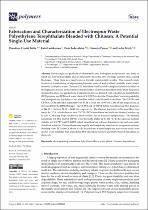| dc.contributor.author | Totito, Thandiwe Crystal | |
| dc.contributor.author | Bode-Aluko, Chris | |
| dc.contributor.author | Katri, Laatikainen | |
| dc.date.accessioned | 2023-04-21T09:45:31Z | |
| dc.date.available | 2023-04-21T09:45:31Z | |
| dc.date.issued | 2023 | |
| dc.identifier.citation | Totito, T.C., Laatikainen, K., Bode-Aluko, C., Pereao, O. and Petrik, L., 2023. Fabrication and Characterization of Electrospun Waste Polyethylene Terephthalate Blended with Chitosan: A Potential Single-Use Material. Polymers, 15(2), p.442. | en_US |
| dc.identifier.issn | https://doi.org/10.3390/polym15020442 | |
| dc.identifier.issn | 2073-4360 | |
| dc.identifier.uri | http://hdl.handle.net/10566/8861 | |
| dc.description.abstract | Textile single-use products are dominantly used for hygiene and personal care, many of which are non-biodegradable and are frequently discarded into sewerage systems, thus causing blockages. Thus, there is a need to move towards water-soluble textiles. This research study focuses on transforming or repurposing biomass material and synthetic reusable waste plastic materials to improve waste. Chitosan (CS) nanofibers could be used in single-use nonwoven fabric or biodegradable tissues, as the water-soluble properties of chitosan nanofibers make them the perfect material for single-use applications. Furthermore, CS was blended with polyethylene terephthalate (PET) polymer and PET-based waste plastic (CS-WPET) to slow the CS nanofibers’ water degradability and strengthen the durability of the nanofiber which could be used as air filters. The CS-TFA and CS-TFA/DCM nanofiber diameters were 95.58 ± 39.28 nm or 907.94 ± 290.18 nm, respectively, as measured from the HRSEM images. The CS-PET and CS-WPET hybrid nanofibers had fiber diameters of 246.13 ± 96.36 or 58.99 ± 20.40 nm, respectively. The thermal durability of the nanofibers was tested by TGA, which showed that CS-TFA/DCM nanofibers had sufficient thermal stability up to 150 ◦C, making them suitable for filter or fabric use at moderate temperatures. The blended nanofibers (CS-PET and CS-WPET) were thermally stable up to 160 ◦C. In the aqueous medium stability test, CS-PET and CS-WPET hybrid nanofibers had a slower degradation rate and were easily dissolved, while the CS nanofibers were rapidly and completely dissolved in an aqueous medium. Blending waste PET with CS allows it to be recycled into a useful single-use, non-woven textile, with greater water solubility than unmodified PET nanofibers but more durability than CS nanofibers on their own. | en_US |
| dc.language.iso | en | en_US |
| dc.publisher | MDPI | en_US |
| dc.subject | Electrospinning | en_US |
| dc.subject | Nanofibers | en_US |
| dc.subject | Hybrid Nanofibers | en_US |
| dc.subject | Waste plastic | en_US |
| dc.subject | Chitosan | en_US |
| dc.title | Fabrication and characterization of electrospun waste polyethylene terephthalate blended with chitosan: A potential single-use material | en_US |
| dc.type | Article | en_US |

